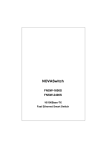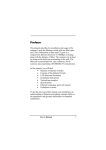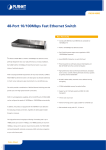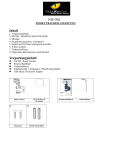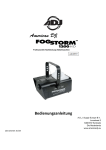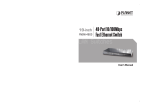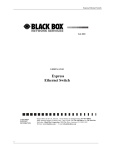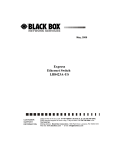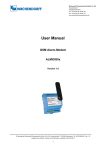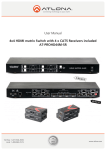Download FNSW-8086/FNSW-8088 User's Guide
Transcript
NOVASwitch Series FNSW-8086F FNSW-8088F Fast Ethernet Fiber-optic Switch FNSW-8086 / 8088F User's Guide i Trademarks Copyright PLANET Technology Corp. 1998. PLANET is a registered trademark of PLANET Technology Corp. The information in this manual is subject to change without notice. All other trademarks belong to their respective owners. Contents subject to revision without prior notice. FCC Warning This equipment has been tested and found to comply with the limits for a Class A digital device, pursuant to Part 15 of the FCC Rules. These limits are designed to provide reasonable protection against harmful interference when the equipment is operated in a commercial environment. This equipment generates, uses, and can radiate radio frequency energy and, if not installed and used in accordance with the Instruction manual, may cause harmful interference to radio communications. Operation of this equipment in a residential area is likely to cause harmful interference in which case the user will be required to correct the interference at his own expense. Reversion This user's manual is for PLANET NOVASwitch Series model -FNSW-8086F / FNSW-8088F Rev: 1.0 (Jun, 1998) Part No: EMHFNSW88F ii NOVASwitch Series Preface This manual describes how to install and use the provided Fast Ethernet Switch, which features eight ports 100BASE-FX Multimode fiber ports, six ports 100BASE-FX plus two ports 10/100BASE-TX switching is also available for this product series. To get the most out of this manual, it is you should have an understanding of networking concepts such as bridging, IEEE 802.3 Ethernet and 100BASE-TX Fast Ethernet, and local area networks (LANs). For more information about these topics, please refer to the Appendix. Chapter Overview Introduction A general overview of switching benefits and the features of the Switch this manual accompanied with. Installation Everything you need to know to install and configure the Switch with your network. Specifications The Switch’s specifications at a glance. Connector Pinouts See Appendix A for more information. Introduction to LAN & Ethernet Technologies See Appendix B for more information. FNSW-8086 / 8088F User's Guide iii Table of Contents INTRODUCTION .......................................................................... III INSTALLATION ........................................................................... III SPECIFICATIONS ......................................................................... III CONNECTOR PINOUTS ................................................................ III INTRODUCTION TO LAN & ETHERNET TECHNOLOGIES ............ III TABLE OF CONTENTS......................................................... IV CHAPTER 1. INTRODUCTION ..............................................1 BENEFITS OF SWITCHING ............................................................1 EIGHT PORTS FIBER-OPTIC ETHERNET SWITCH ..........................1 PRODUCT FEATURES ...................................................................3 PACKING LIST .............................................................................3 FRONT PANEL .............................................................................5 Ports .......................................................................................5 LED Indication.......................................................................6 Uplink Button .........................................................................9 Activity Status.......................................................................10 CHAPTER 2. INSTALLATION..............................................13 SELECTING A SITE FOR THE SWITCH .........................................13 CONNECTING TO POWER ...........................................................14 CONNECTING TO YOUR NETWORK ...........................................14 CHAPTER 3. SPECIFICATIONS...........................................17 APPENDIX A - CONNECTOR PINOUTS ............................19 iv NOVASwitch Series APPENDIX B – INTRODUCTION TO LAN & ETHERNET TECHNOLOGIES.......................................21 FNSW-8086 / 8088F User's Guide v Chapter 1. Introduction Benefits of Switching Ethernet switching technology has dramatically boosted the total bandwidth of a network. It puts configuration flexibility and bandwidth adaptability into the local workgroups where the majority of work is generated. It further eliminates congestion problems inherent to the CSMA/CD protocol and improves predictable response time under heavy network loads. Expensive routing equipment was used in the past to reduce the congestion under heavy loads. The new wave of object-oriented client and server applications demands higher bandwidth and tighter integration of client work stations with servers. The old shared-access Ethernet technology provides neither enough bandwidth nor predictable response time for this new wave of workgroup computing. Fast Ethernet switching not only satisfies both technical and business requirements, but also preserves the user’ s existing investment in the huge 10 BASE-T Ethernet installed base. This compatibility ensures a path for users to add, change, and migrate to Fast Ethernet as demands emerge. It also provides a low cost and flexible bandwidth solution directly to local workgroups where the majority of work is generated, reducing the need for expensive network equipment. Eight Ports Fiber-Optic Ethernet Switch The eight-port Fast Ethernet switch offered here adds 100Mbps switching performance in a cost-effective desktop package. The FNSW-8086 / 8088F User's Guide 1 Switch has eight switching ports, each a 10/100 port capable of autosensing both speed and half/full duplex mode. With the demand for fiber, NOVASwitch's eight-port switch provides another model, FNSW-8088F and FNSW-8086F in addition to the original switch. The FNSW-8088F has eight multimode fiber ports. And for FNSW-8086F, it has 6-port 100BASEFX ports and 2-port 10/100BASE-TX ports. This switch makes it possible to join a 100Mbps Fast Ethernet network to an existing 10Mbps Ethernet network (FNSW-8086F). Its internal cache buffers the traffic from the higher bandwidth 100Mbps segment to the 10Mbps segment. If you later decide to make both segments 100Mbps Fast Ethernet, the ports of the switch will automatically sense the change and adjust to 100Mbps operation. In addition to the benefits of integrating 10Mbps and 100Mbps networks through TP ports, this switch is also useful for segmenting networks that is bogged down with excess traffic as a fiber-optic switching backbone. By splitting a network into several segments and bridging them, you can cut the traffic load on your network and reduce collisions on each segment, especially if you can minimize intersegment traffic by placing users and devices that normally talk to each other on the same segment. This switch fully complies with IEEE802.3u, 100BASE-TX, 100BASE-FX, IEEE802.3, and 10BASE-T standards. It features "wire-speed” switching mechanisms as well as the ability to filter local traffic, collisions, and error packets to maximize network performance. 2 NOVASwitch Series This eight-port switch also facilitates an affordable and efficient migration path to 100Mbps Fast Ethernet and can continue to enhance your network's performance even if you upgrade your existing network with standard Ethernet applications, internetworking systems and client-side adapters to minimize migration costs. Product Features This eight-port switch provides the following features: ♦ Eight 100BASE-FX switching ports (ST Interface) ♦ Full-duplex support on each port (default) for up to 2Km wiring ♦ Two-port 10/100BASE-TX, with six-port 100BASE-FX for multiple choice of TP wiring ♦ Designed in compliance with 10BASE-T, IEEE802.3u, 100BASE-TX and 100BASE-FX standards. ♦ Comprehensive array of LED indicators that communicate the status of the switch and troubleshooting information. ♦ Dynamic learning mode that automatically adjusts to the network configuration. ♦ Runt and CRC filtering eliminates erroneous packets to optimize network bandwidth. ♦ Full compatibility with standard Ethernet applications, internetworking systems and client-side adapters to minimize migration costs. Packing List FNSW-8086 / 8088F User's Guide 3 When you unpack the switch, you should find the items listed below. Please inspect the contents, and report any apparent damage or missing items immediately to your authorized reseller. The Eight-port Switch Users Manual AC power cord Rack Mount Ears with Screws 4 NOVASwitch Series Front Panel The front panel of the switch has eight ports and an array of LED indicators to provide you with instant feedback on the status of the switch. Figure 1: Front Panel of FNSW-8086F/ FNSW-8088F Ports Ports of this switch are capable of accepting 100BASE-FX with ST interface connections. For FNSW-8086F, the two TP ports support 10/100BASE-TX with Cat. 3, 4, 5 (100Mbps) twisted pairs connection. When connects to a 100BASE-TX network, the ports operate at 100Mbps in half-duplex mode and 200Mbps in full-duplex mode. When connects to a 10BASE-T network, the ports operate at 10Mbps in half-duplex mode and 20Mbps in full-duplex mode. With the fiber-optic port , when it connects to a 100BASE-FX network, the ports operate at 100Mbps in half-duplex mode and 200Mbps in full-duplex mode (default). The maximum range of a 100BASE-TX network connected to the switch is 100 meters with Category 5 shielded twisted-pair and unshielded twisted-pair (STP/UTP) cable. A 10BASE-T network may range up to 100 meters with Category 3, 4, or 5 STP/UTP cable. FNSW-8086 / 8088F User's Guide 5 As for the length of FX fiber link between a switch and Data Terminal Equipment, FX is capable to span at most 2 Kilometers using 62.5/125-micron fiber-optic cable. The following table summarizes the port and cable specifications for this switch. Speed Connector Port Speed Half/Full Duplex Cable 100BASE-TX RJ-45 100/200 Mbps 100M, Category 5 STP/UTP 10BASE-T RJ-45 10/20 Mbps 100M, Category 3, 4, or 5 STP/UTP 100BASE-FX Straight-tip (ST) 100/200 Mbps 62.5/125 micron fiberoptic cable LED Indication The array of LED indicators on the front panel conveys status and configuration information to help you monitor and troubleshoot the switch. 6 NOVASwitch Series Figure 2-1: LED & Button Indicators for FNSW-8086F Œ Po r t Status TP Ports: Each port has an array of six LEDs to show status information. The LEDs are identified by a corresponding array of captions located below the LEDs on the front panel. LNK: The link indicator is the top-left LED. It is illuminated whenever the port is connected to another working networked device. 100: The top-right LED shines whenever the switch detects that the corresponding port is connected to a 100BASE-TX segment. TX: The middle-left LED comes on when the port is transmitting data. FNSW-8086 / 8088F User's Guide 7 FDX: The full-duplex LED (the middle-right LED) is illuminated when the port is operating in full-duplex mode. When this LED is off, the port is operating in half-duplex mode. RX: The lower-left LED comes on when the port is receiving data. COL: The collision LED at the lower-right in the array shines when the switch detects packet collisions on the port. • Port Utilization The Port Utilization LEDs indicates how much traffic each port is handling, measured as a percentage of the port's bandwidth. Column 1 corresponds to Port 1, Column 2 to Port 2, Column 3 to Port 3, etc. As traffic on a port increase, the LEDs for its column will shine progressively from bottom to top. 8 NOVASwitch Series Ž Uplink Status This LED is illuminated when the uplink button is pressed down. • Power This LED comes on when the switch is connected to a power supply and turned on. Uplink Button The location of the uplink button is shown in Figure 2-1. • Uplink Button Use the uplink port with the uplink button pressed down for connecting to a regular port of a hub or another switch. If connecting to an uplink port of a hub or another switch, any of the switch’s RJ-45 ports can be used. Figure 2-2: LED Indicators of FNSW-8088F FNSW-8086 / 8088F User's Guide 9 Œ Port Status Fiber-optic ports Each port has an array of three LEDs to show status information. The LEDs are identified by a corresponding array of captions located beside the LEDs on the front panel. LINK: The link indicator is the top LED. It is illuminated whenever the port is connected to another working networked device. ACT: The middle LED comes on when the port is transmitting or receiving data. FDX: The full-duplex LED (the middle LED) is illuminated when the port is operating in full-duplex mode. When this LED is off, the port is operating in half-duplex mode. • Port Utilization The Port Utilization LEDs indicates how much traffic each port is handling, measured as a percentage of the port's bandwidth. Column 1 corresponds to Port 1, Column 2 to Port 2, Column 3 to Port 3, etc. As traffic on a port increase, the LEDs for its column will shine progressively from bottom to top. Ž Power This LED comes on when the switch is connected to a power supply and turned on. Activity Status 10 NOVASwitch Series • TX : Transmit Data RX : Receive Data There is no uplink issue for fiber Switch; thus the uplink status does not apply to FNSW-8088F. FNSW-8086 / 8088F User's Guide 11 12 NOVASwitch Series Chapter 2. Installation This chapter presents step-by-step installation instructions for this eight-port Fiber-optic Fast Ethernet Switch. Selecting a Site for the Switch As with any electronic device, you should place the Switch where it will not be subjected to extreme temperatures, humidity, or electromagnetic interference. Specifically, the site you select should meet the following requirements: ♦ The room temperature should be between 32 and 104 degrees Fahrenheit (0 to 40 degrees Celsius). ♦ The relative humidity should be less than 90 percent, non-condensing. ♦ Surrounding electrical devices should not exceed the electromagnetic field (RFC) standards for IEC 801-3, Level 2 (3V/M) field strength. ♦ Make sure that the switch receives adequate ventilation. Do not block the ventilation holes on the side of the switch or the fan exhaust port on the rear of the switch. ♦ The power outlet should be within 1.8meter (6 feet) of the switch. Detailed specifications may be found on page 22 and 23. FNSW-8086 / 8088F User's Guide 13 Connecting to Power Connect the supplied AC power cord to the receptacle on the back of the switch, and then plug the cord into a standard AC outlet with a voltage range from 100 to 240 VAC. Turn the Ethernet switch on by flipping the ON/OFF switch on the rear of the unit to the I (ON) position. The O position is OFF. Connecting to Your Network 10/100BASE-TX TP Ports Connect cables to computers or network segments into the RJ45 ports on the front of this switch. It does not matter which port you select. All the non-fiber ports support 10BASE-T or 100BASE-TX with full or half duplex. Use the uplink port with the uplink button pressed down for connecting to a regular (i.e. non-uplink) port of a hub or another switch. If connecting to an uplink port of a hub or another switch, any of the eight ports can be used. To connect two regular RJ45 ports between any two switches or hubs, you need a crosswire cable. The cable must be a Category 5 shielded twisted-pair or unshielded twisted-pair (STP/UTP) cable for 100BASE-TX, or Category 3, 4, or 5 STP/UTP cable for 10BASE-T. 100BASE-FX Fiber-optic ports 14 NOVASwitch Series Prepare a pair of fiber optic cables with ST type connectors at both ends. If you are making a connection to a server or workstation, be sure that it has a properly installed 100BASE-FX network interface card. Connect the Rx/Tx jacks on the target device to the Tx/Rx jacks on the switch. FNSW-8086 / 8088F User's Guide 15 16 NOVASwitch Series Chapter 3. Specifications Applicable Standards 10BASE-T, IEEE 802.3 100BASE-TX, IEEE 802.3u Ports 10/100BASE-TX Autosensing Ports 100Base-FX Ports FNSW-8086F 2 6 FNSW-8088F 0 8 Speed 100BASE-TX: 200Mbps full-duplex 100Mbps half-duplex 10BASE-TX: 20Mbps full-duplex 10Mbps half-duplex 100BASE-FX: 200Mbps full-duplex 100Mbps half-duplex Performance 148,800pps forwarding rate per port. TP port switch LED Indicators Link, 10/100Mbps, Transmit, Receive, Duplex, Collision, Port Utilization, Power FX port LED Indicators Link, Activity, Duplex, Port Utilization, Power FNSW-8086 / 8088F User's Guide 17 Dimensions 440 X 205 X 45mm Rack-mount size Weight 1.3kg (2.5lb) Power Input 100 ~ 250 VAC, 47/63 Hz, 2A Power Consumption 12 W Operating Temperature 32 ~ 104 degrees F (0 ~ 40 degrees C) Humidity 10 ~ 90%, non-condensing Altitude 10,000 ft (3048 m) Emissions FCC part 15 Class A, CISPR Class A, VCCI-I CE Mark Safety 18 UL, CSA, TUV/GS NOVASwitch Series Appendix A - Connector Pinouts Figure 6: RJ-45 Connector and Cable Pins The following table lists the pinout of the switch’s 10/100BASE-T/TX ports. Pin Regular Ports Uplink port 1 Input Receive Data + Output Transmit Data + 2 Input Receive Data - Output Transmit Data - 3 Output Transmit Data + Input Receive Data + 4 NC NC 5 NC NC 6 Output Transmit Data - Input Receive Data - 7 NC NC 8 NC NC FNSW-8086 / 8088F User's Guide 19 20 NOVASwitch Series Appendix B – Introduction to LAN & Ethernet Technologies In the last ten years, as communication and business applications become increasingly complex, computer network has evolved as a very important part of the enterprise infrastructure. Communication systems like Local Area Network (LANs) have grown into a sophisticated, powerful, yet flexible technology today. Among different types of Local Area Networks, such as FDDI, ATM, Token Ring and Apple Talk, Ethernet strikes a good balance between speed, price, ease of installation, and supportability. This primer helps to explain this most popular technology and its associated products such as Ethernet hubs and switches. LAN In order to reduce the expense on computer hardware and software and to easily share information, LAN technologies were developed for people to share distributed computing resources. LAN connects independent computers, file servers, printers, etc. together within a confined geographic area, usually a single building or a college campus. As LAN expands to link hundreds and thousands of computers, various network protocols and media have developed to meet the organization’ s different requirements. At times, multiple LANs that are geographically dispersed may need to connect together and become so called Wide Area Network (WAN). FNSW-8086 / 8088F User's Guide 21 Ethernet Technologies More than 80 percent of all Local Area networks are installed with Ethernet. The Institute of Electrical and Electronic Engineers (IEEE) define the standard of Ethernet as IEEE 802.3. The IEEE 802.3 provides rules for configuring Ethernet LANs, specifies how elements should interact with one another, and different types of media that can be used, as well as data rate (10Mbps) of Ethernet. Ethernet supports just about all kinds of popular network protocols. It is one of the most ideal networking technologies today. Fast Ethernet For networks that need higher transmission speeds, IEEE has also established the standard 802.3u, which raises the Ethernet speed limit from 10 Mbps to 100 Mbps. This allows a network device to transmit data through media such as category 5 UTP (Unshielded Twisted Pair) cable or fiber optic cable at the rate of 100 Mbps instead of 10 Mbps. A number of other high-speed LAN technologies are also available for high bandwidth and good client server response time. However, Fast Ethernet offers the best solution that provides smooth migration from 10Base-T technology to 100 Base-TX. It requires only minimal changes with existing cabling infrastructure. Fast Ethernet and its successors have been said to be the most cost effective and high-performance networking solutions of the future. The Fast Ethernet contains three different cabling schemes. 100Base-TX for use with category 5 UPT/STP cable, 100BaseFX for use with Multi-mode fiber-optic cable, and 100Base-T4 for 22 NOVASwitch Series use with cable 3,4,or 5 UPT cable. Among three of them, 100Base-TX is most compatible to 10Base-TX. It allows users to retain the existing 10Base-T cabling infrastructure, thus becomes the most popular Fast Ethernet technology. Gigabit Ethernet is still in the process of development. Other than supports higher data transfer speed, this technology also promises for an easy migration path. Ethernet Products Hub Hub is a central connection point for wiring the network. It connects two or more Ethernet segments of any media type. When transmitting signal begins to deteriorate, which is caused by the limitation of media length, hub simply takes the incoming signal and repeats or amplifies it out to all ports connected. Hub, also called repeater, only allows users to share Ethernet. Individuals of a shared network can only get a percentage of the available network bandwidth, therefore, a network of repeaters also named “ Shared Ethernet” . Switches The function of a switch is to connect separate networks together. A Switch maps the Ethernet addresses of the nodes residing on each network segment and then allows only the necessary traffic to pass through. When a packet is received by the switch, the switch determines the destination and source segments of a packet and forward it to the right direction or drop it if the destination and the source are originated from the same network. Switches also prevent bad or misaligned packets from spreading FNSW-8086 / 8088F User's Guide 23 into the rest of network, thus increasing efficiency of the network transmission. There are two basic architectures of LAN switches, cut-through and store-and-forward. Cut-through switches only examine the destination address before forwarding it on to its destination segment. A store-and-forward switch accepts and analyzes the entire packet before forwarding it to its destination. It allows the switch to catch certain packet errors and keep them from propagating through the network. Today there are a large number of hybrid switches available that mix both cut through and store-and-forward architectures. 24 NOVASwitch Series Part No.: EMHFNSW88F CE ISO9002
































